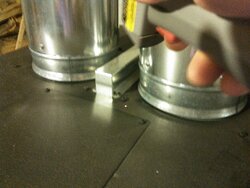Thanks for the temp stats guys. Hey
@Builderml, would you mind getting me a pic of what it looks like on your unit where the blower attaches to the furnace. Just pull the filter and show me that area, if ya don't mind, thanks!
Why are his ducts temps similar to mine but yet not enough to keep his house warm when his house has less of a heat requirement.
Because I'm not getting duct temps as high as yours. The temps I stated were 2' above the furnace, I haven't checked duct temps further down the line, or at the registers, I probably should though. I only get temps above 100* while the damper is open, or maybe for a while after the damper closes during the intense part of the secondary burn. Once that is over we are definitely under 100* duct temps right above the furnace. Like I said before, If I had 110-120* duct temps (consistently) I would have no problem heating the place with that, but 90s, even 80s (remember, I have the old style fan switch in the back) during the end of the burn cycle are barely cuttin it, and the weather is pretty mild, so I don't have a lot of faith that this is gonna work out when the temps drop. I guess I need to move the fan switch, see if that makes any real difference, one thing at a time though.
Any insight or comments will be welcome.
My 2 cents, lower your blower speed 1 or 2 speeds, your static pressures are higher than they need to be.
An update on the case of the "missing heat heater"
I'm away for the holiday and I forgot my camera, so y'all gonna hafta wait for the pics. But I tore the Tundra apart last night to clean the firebox above the baffle and super clean the HEs. Good news was that the secondary air tubes came right out. I had read where some said that the tubes warp after a while and are very difficult to get out. Baffle came right out and looked to be in relatively good shape. There definitely was some light colored (white) fluffy soot build up in the front part of the upper firebox. It was more creosote lookin at the back of the firebox and going into the HEs. Things cleaned up pretty well in there. What I found interesting was that the top of the firebox is double walled. They have a thin piece of sheet metal plug welded to the actual top of the firebox. The light colored soot was where the double wall is, with some darker spots where the welds are, probably due to the heat transfer to the main body being cooled by the blower. The darker stuff was in the back where it goes to single wall.
I cleaned the HEs again, I found that the 4x6 rectangular wire brush that I have for cleaning the HEs on my Yukon actually worked pretty well getting into the side HEs of the Tundra, even the center one. I thought they were pretty clean until I shined the light in there and could see ridges where some of the buildup came off. It looks like maybe there was a thin layer of creosote once upon a time that got baked on and was REALLY hard to get off, lots of scraping with various tool and brushes. Kinda like when the dental hygentist scrapes plaque off your teeth.

I ran out of time to get it all, but 95% of it is gone. If Santa brings me a Soot Eater for Christmas I will try to get the rest off with that.

The tricky thing is, without very close inspection, you would have never been able to tell that the HEs weren't clean, like down to bare metal, it was black and smooth.
My theory was that I wasn't getting any heating from the top of the firebox (like you do from a stove) but after finding the double wall firebox top, it is apparent to me that they are not that concerned with getting heat from the firebox and are relying mostly on the HEs to do the heavy lifting. I fired back up last night but was running out of time to play with things so I don't know if I made any real progress or not. My initial impression was that it didn't make a big difference.




 Some may have success tying into existing duct work if small enough while others with larger duct work my not be satisfied,
Some may have success tying into existing duct work if small enough while others with larger duct work my not be satisfied,
 I ran out of time to get it all, but 95% of it is gone. If Santa brings me a Soot Eater for Christmas I will try to get the rest off with that.
I ran out of time to get it all, but 95% of it is gone. If Santa brings me a Soot Eater for Christmas I will try to get the rest off with that. 